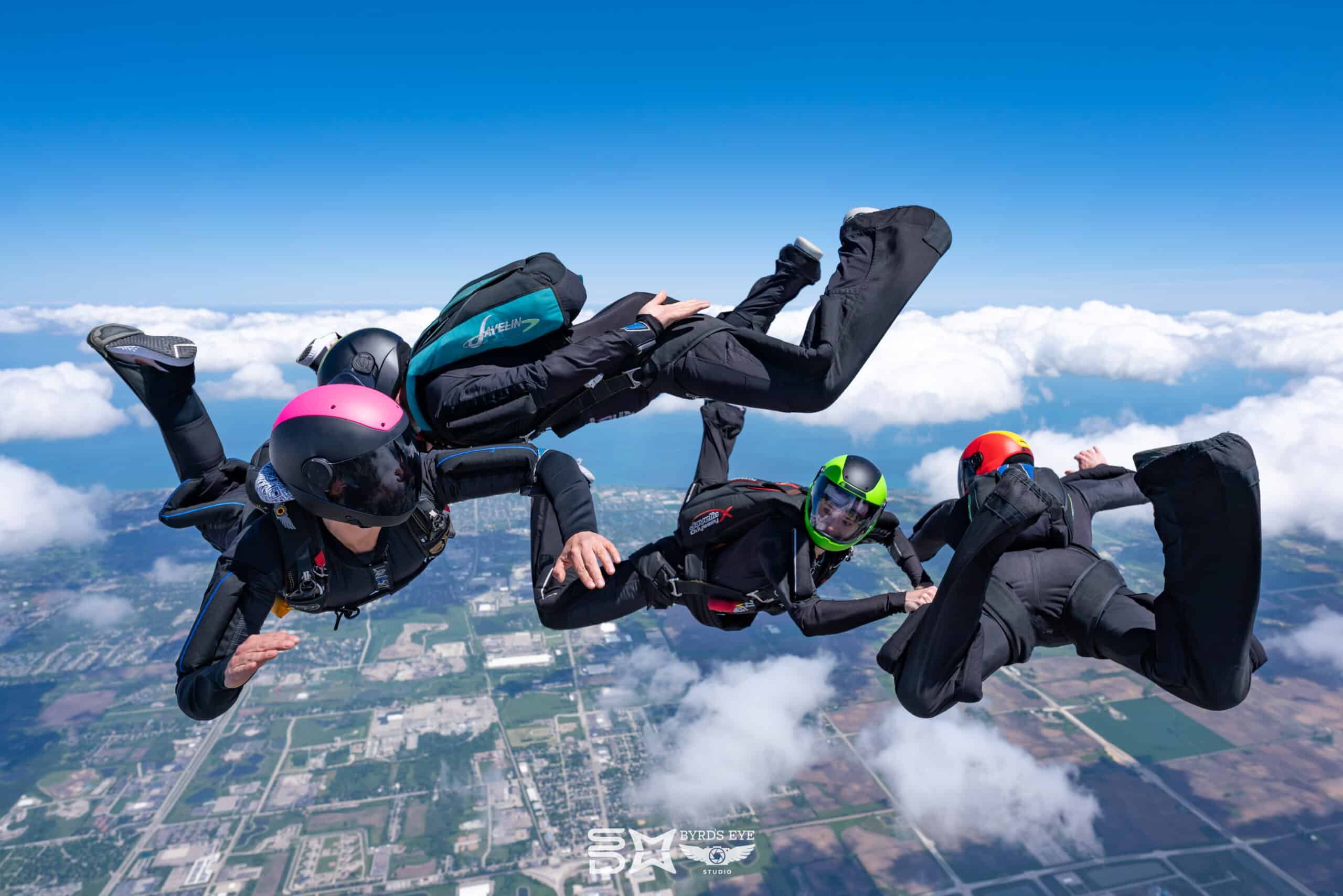Competitive Skydiving
SDMW is the proud home to many skydiving teams and athletes. Which might make the average person wonder, what is competitive skydiving? National and World Championship competitions for skydiving are held every year and include a multitude of different disciplines within skydiving.
Formation Skydiving
Formation skydiving is by far the most popular form of competition. Teams consist of 4, 8 or 16 flyers plus a dedicated videographer to capture each competition round to submit for judging.
Formation skydiving can be performed in a variety of orientations. Your orientation is your body position, relative to the ground.
- Belly Flying – A belly-to-earth orientation.
- Head-Up or Sit-Flying – A seated or standing position where your feet are pointed at the earth.
- Head-Down or Vertical Flying – An “upside down” position where your head is pointed at the earth.
- Back-Flying A back-to-earth orientation.
Standard Formation Skydiving (FS): Teams consisting of 4, 8 or 16 jumpers flying in a belly-to-earth orientation. 4-way FS is the most popular discipline of competitive skydiving worldwide.
Vertical Formation Skydiving (VFS): Teams consisting of 4 jumpers flying in a head-up or head-down orientation.
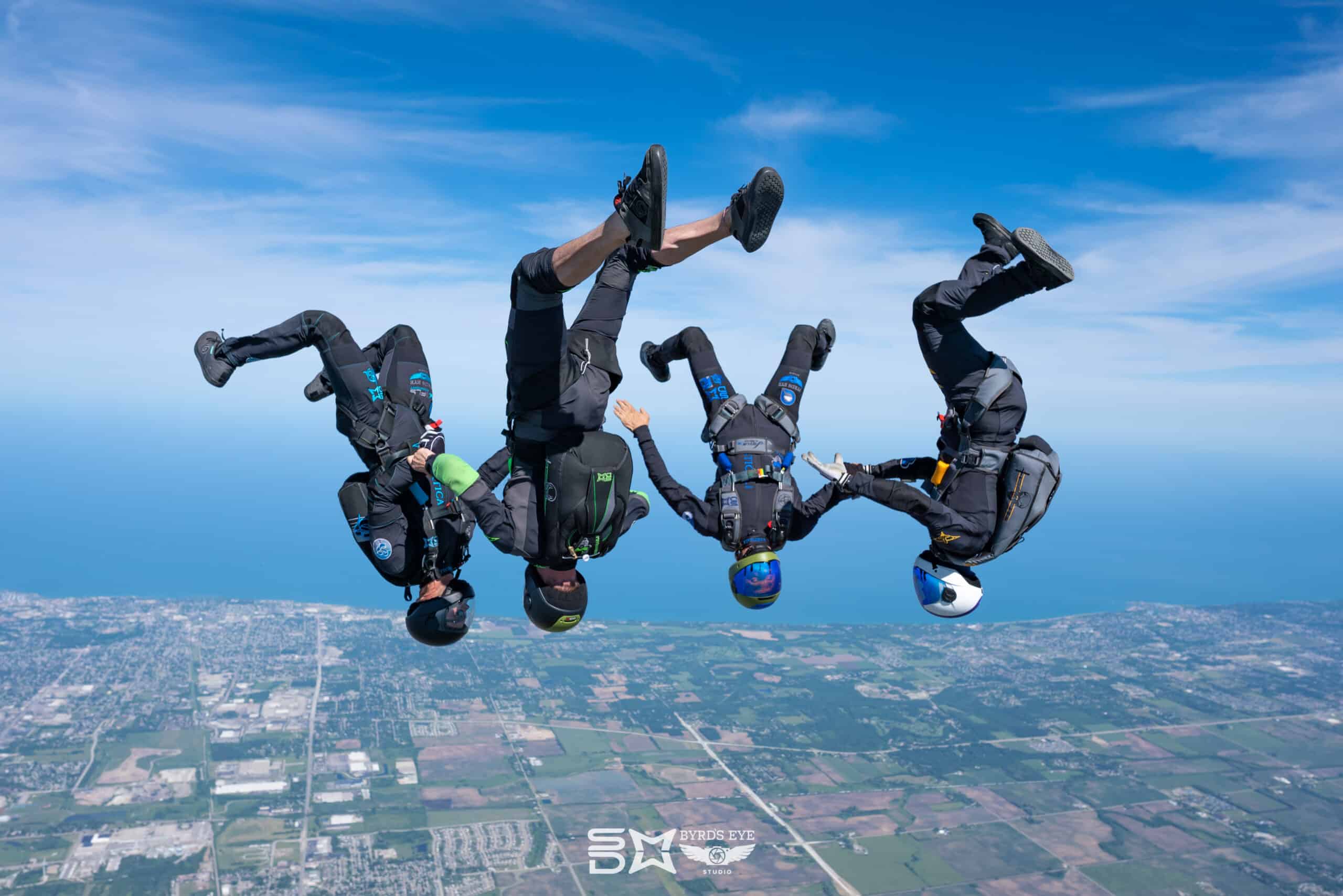
Mixed Formation Skydiving (MFS): Teams consisting of 2 jumpers flying a headup, headdown, belly-to-earth, or back-to-earth orientation.
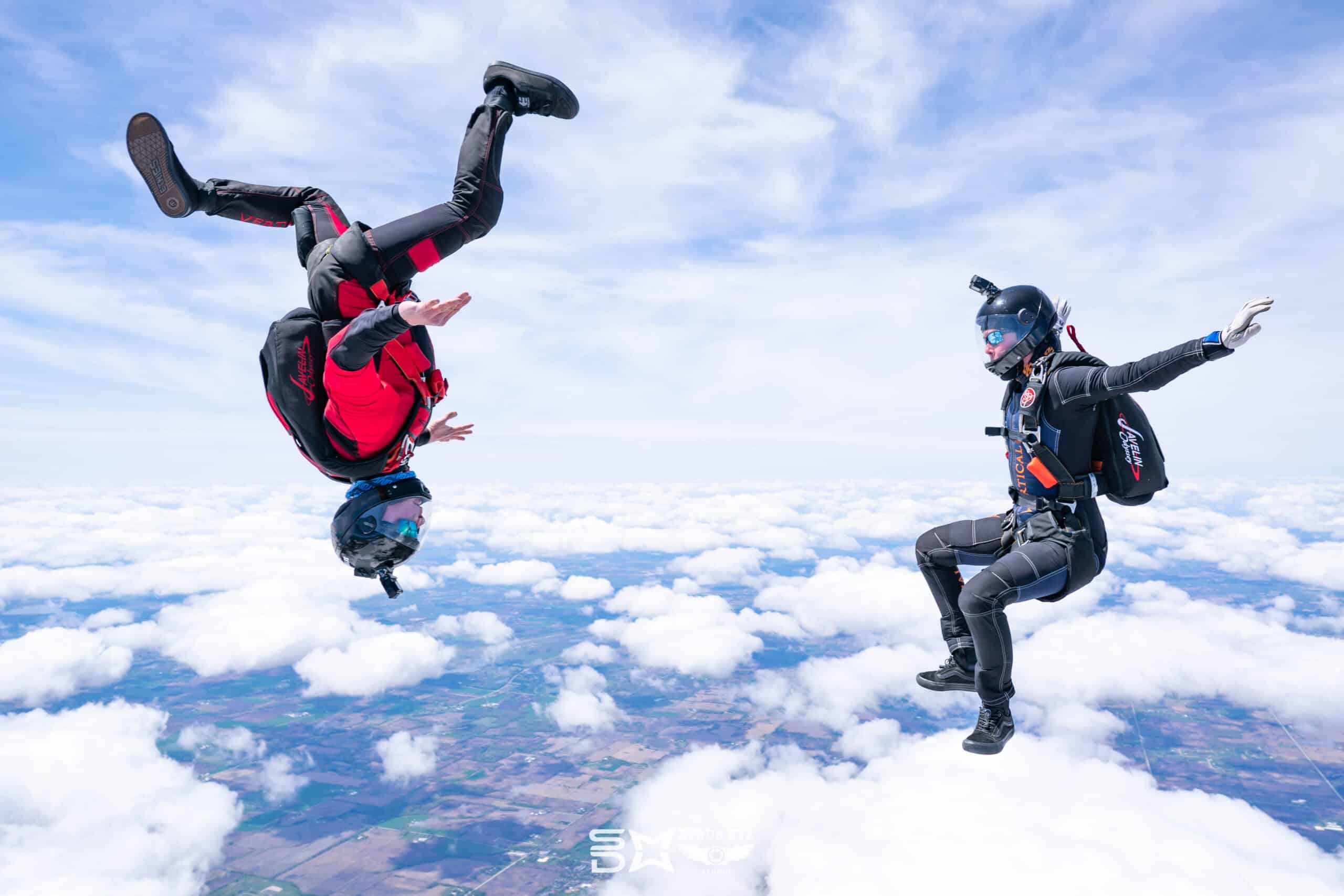
DIVE POOLS & SCORING
Each formation skydiving discipline has a “dive pool” of specific formations and maneuvers they may be asked to perform in a given round. 4-5 of these formations and maneuvers will be chosen for each of 10 rounds to create a random sequence. Each team will have an allotted “working time” (35 seconds for 4way, 50 seconds for 8-way and 16-way) to repeat the sequence as many times as possible from the moment they leave the aircraft. Each formation in the sequence is worth 1-2 points. The team with the most points at the end of 10 rounds wins.
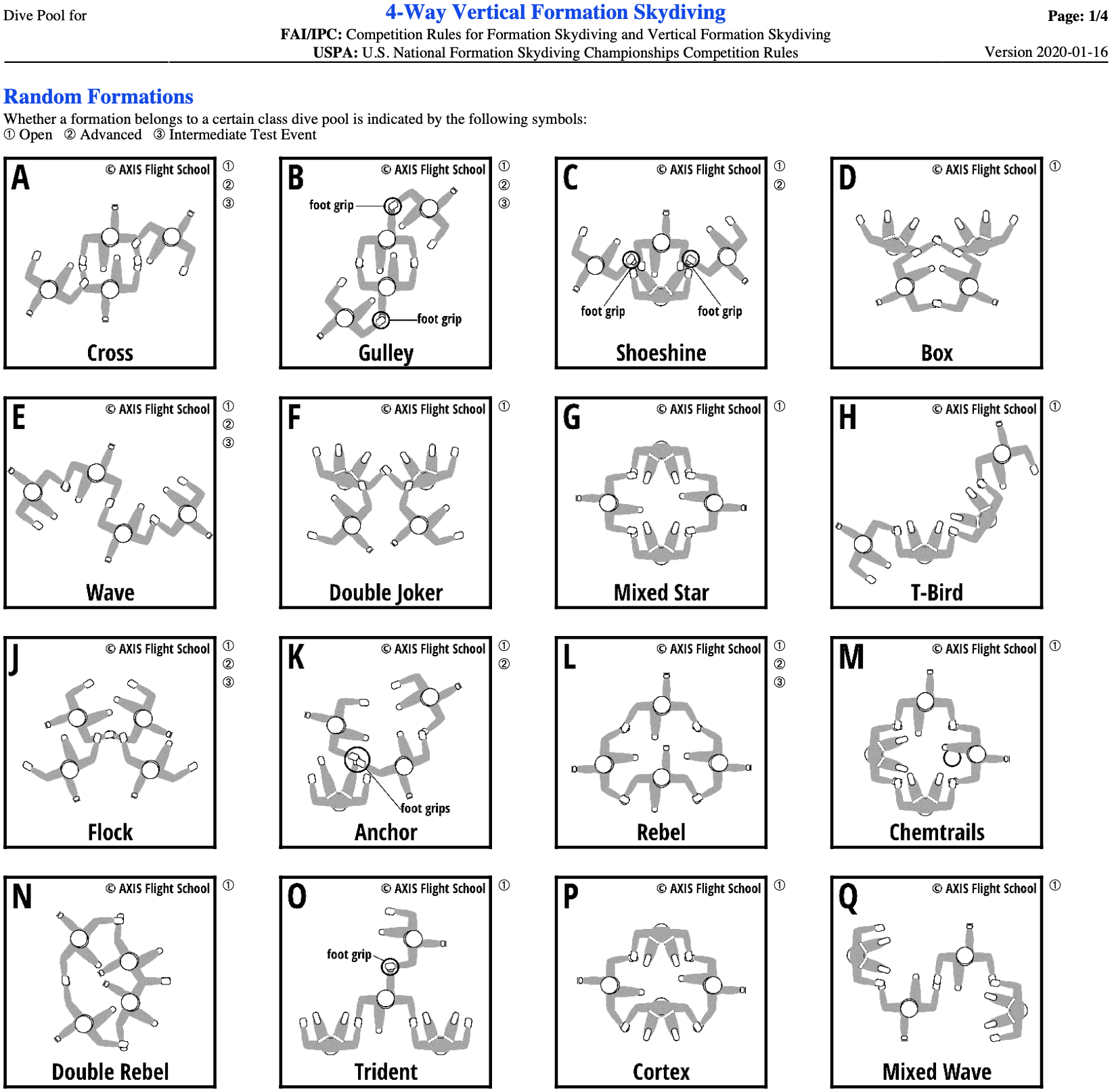
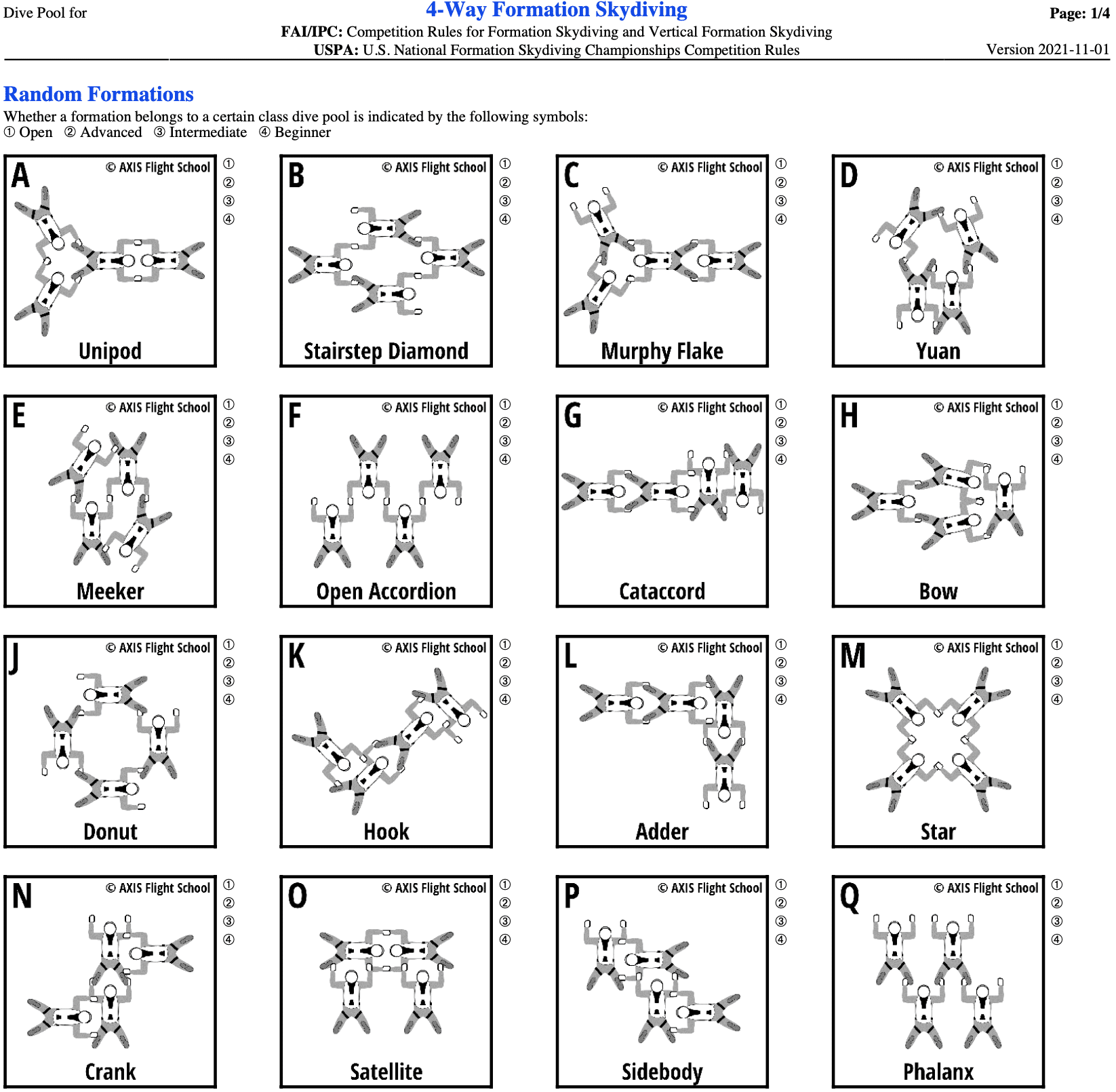
- Random Formations (1pt)- These are single, static formations. This means the formation requires no “inter” maneuver to be performed. Once the formation is built correctly, with all the correct grips in place, 1 point is awarded.
- Block Formations (2pts)- These are non-static formations consisting of a “top” or beginning formation and a “bottom” or finishing formation with a connecting maneuver in between. If the top and bottom formation are built correctly and the inter maneuver is performed correctly, 2 points will be awarded. If the top is built correctly but the inter is not performed, performed incorrectly or the bottom is not performed, only 1 point will be awarded.
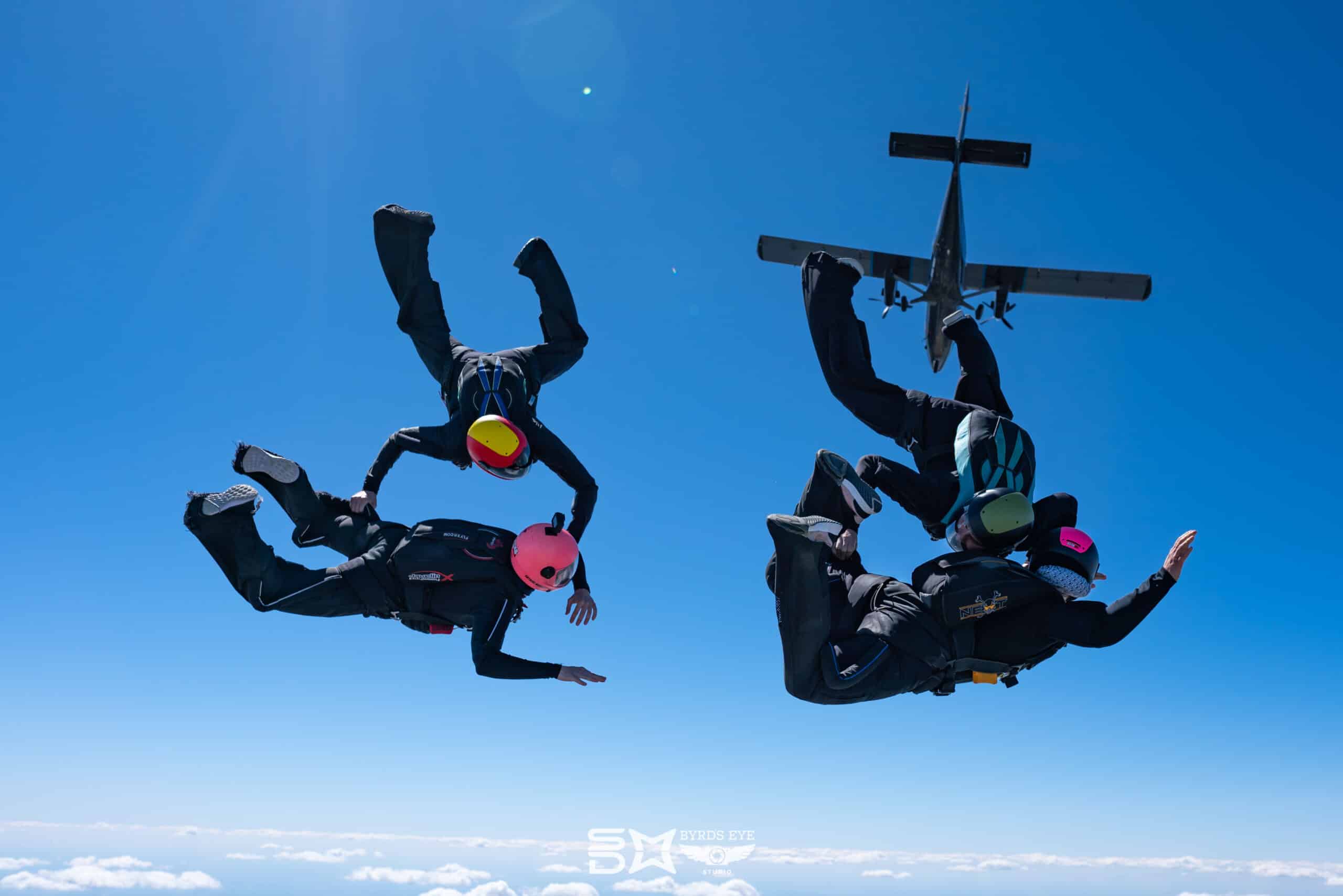
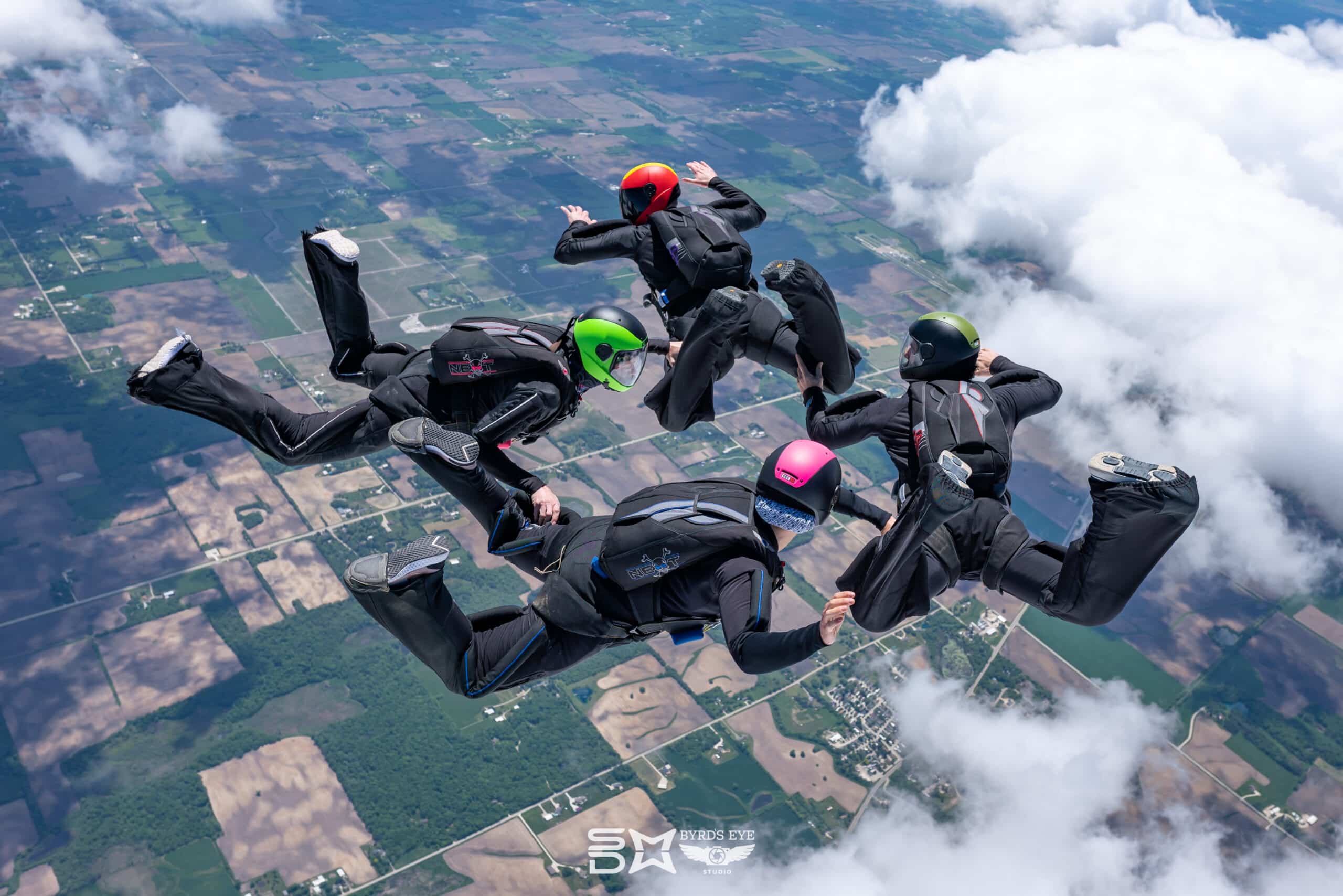
10WAY SPEED - Teams of 10 jumpers plus a videographer will try to build a single, static, formation from the 10-way divepool in as little time as possible. They must leave the aircraft unlinked (not holding on to one another) and build one specific formation for each round and hold it for at least 5 seconds. The lowest score (time) after 6 rounds wins!

VIDEOGRAPHERS
The video flyer is arguably the most important role on any competitive skydiving team. Without video, there’s nothing to judge. One of the most challenging tasks for the videographer is sync up with the team to capture the exit. Many teams will exit the plane already building the first formation of the sequence, so mis-timing the exit can cost the team a lot. A knowledge of the dive pool is also important so the video flyer can be in the correct position at the correct angle to capture certain formations. Videographers must also be able to quickly recognize and adjust to changes in fallrate to match the team. They are often the unsung heroes of any competition.
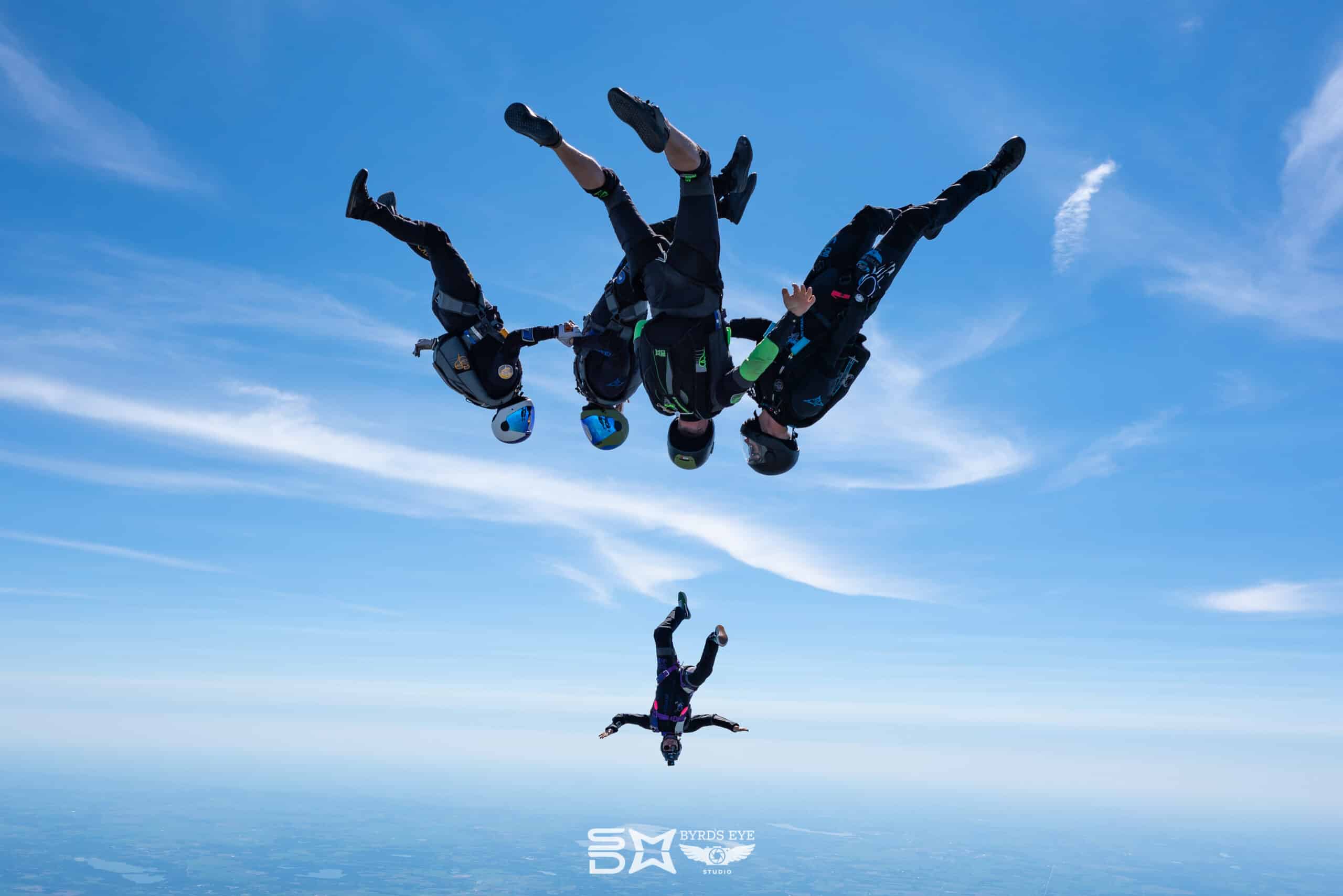
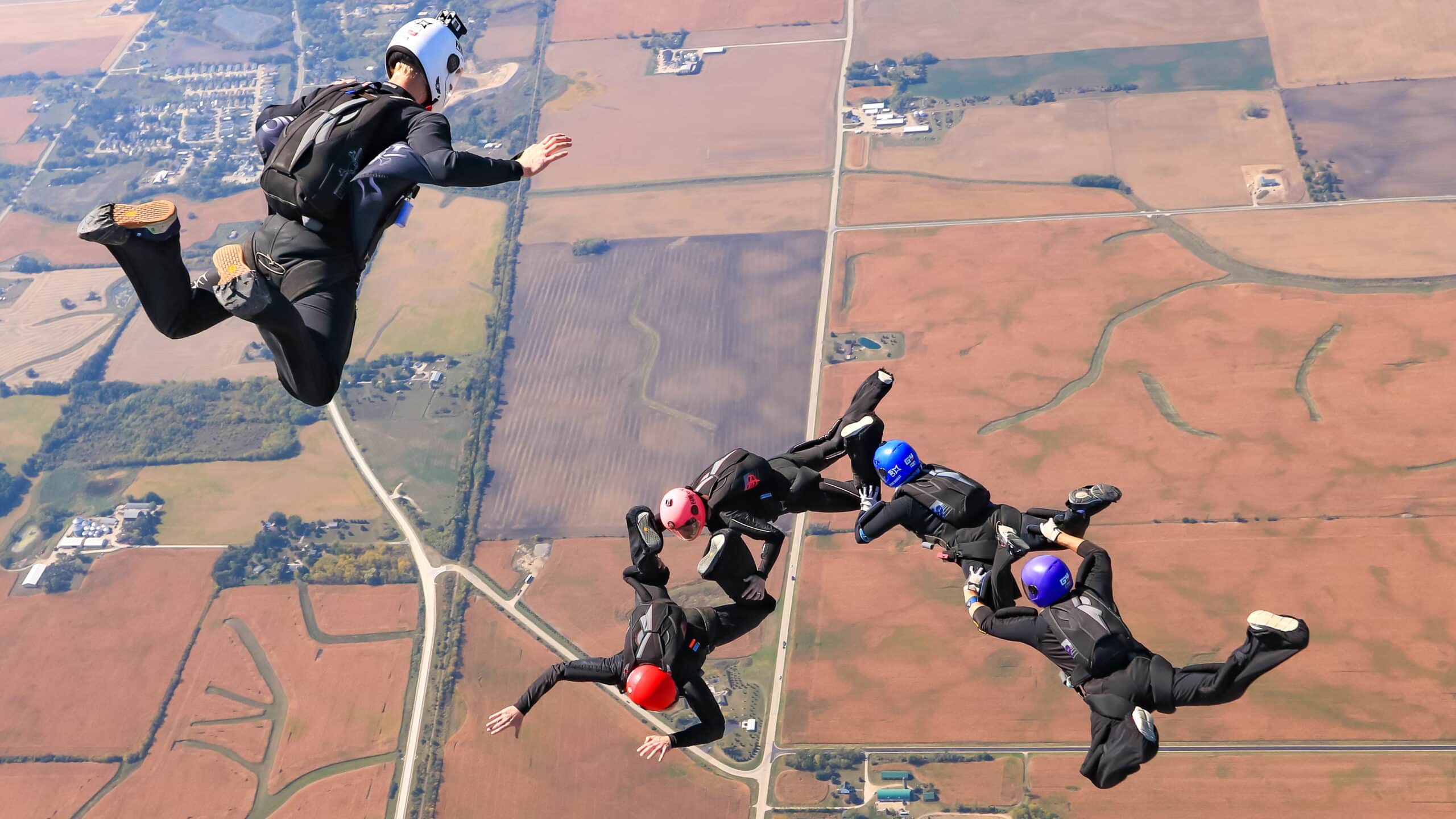
CANOPY PILOTING (CP) AKA “SWOOPING”
Canopy piloting is a rapidly growing competitive discipline within skydiving. It involves performing advanced parachute maneuvers over a purpose-built pond of water. Competitors are judged in 3 category events: Speed, Distance and Accuracy. The parachutes used for these events are small and specifically designed for both speed and performance. Top athletes can achieve speeds over 100mph across the ground/water!
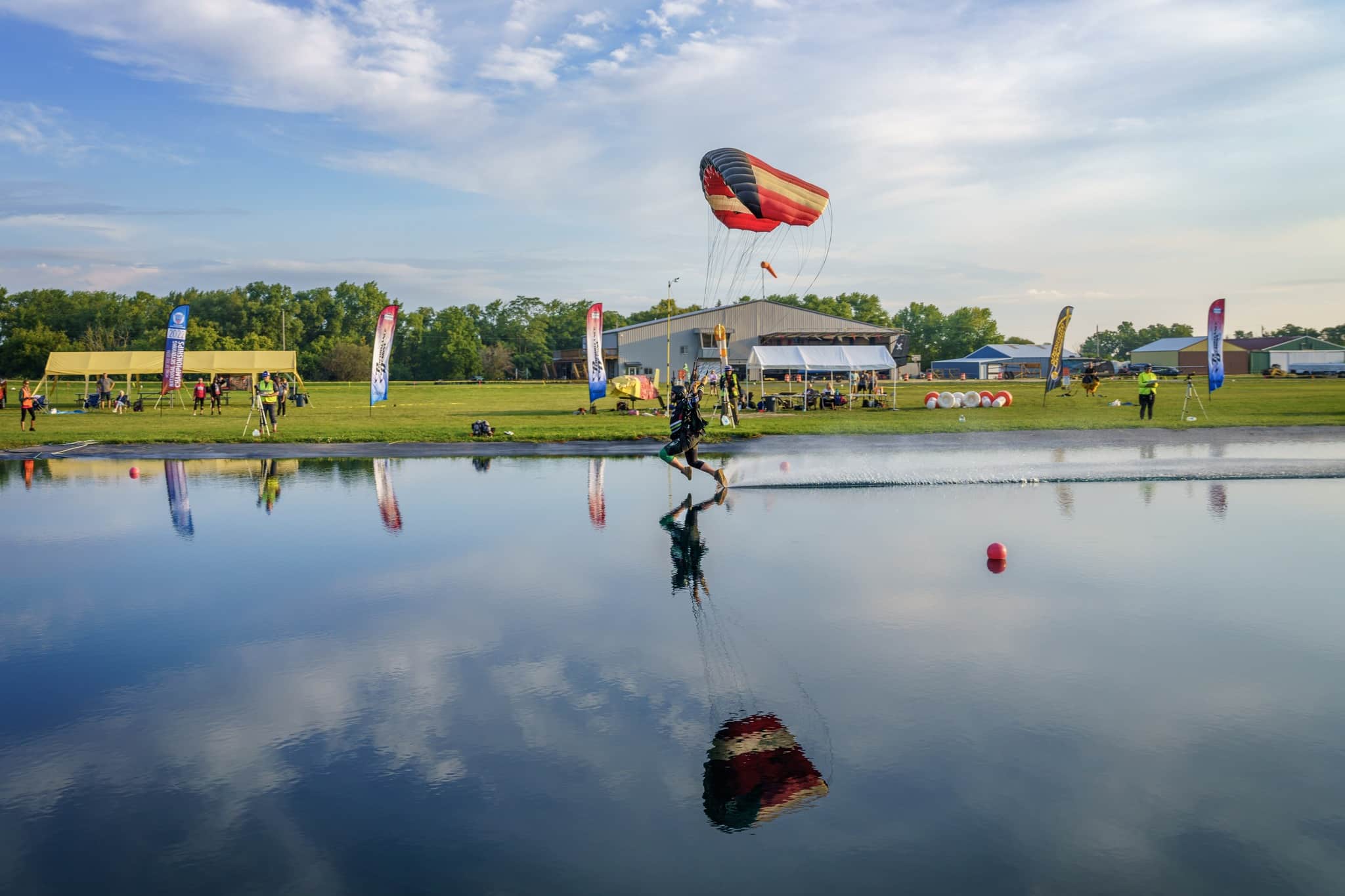
Speed - The competitors must enter the course, which begins over a body of water. Some part of the competitor’s body has to pass between and below the “gates” (2 poles or buoys positioned at the entrance to the course). They must then stay within the other gates positioned along the course which will curve to the left or right. The competitor’s time from entry to exit of the course is recorded and becomes their score. The lowest score/time will win.
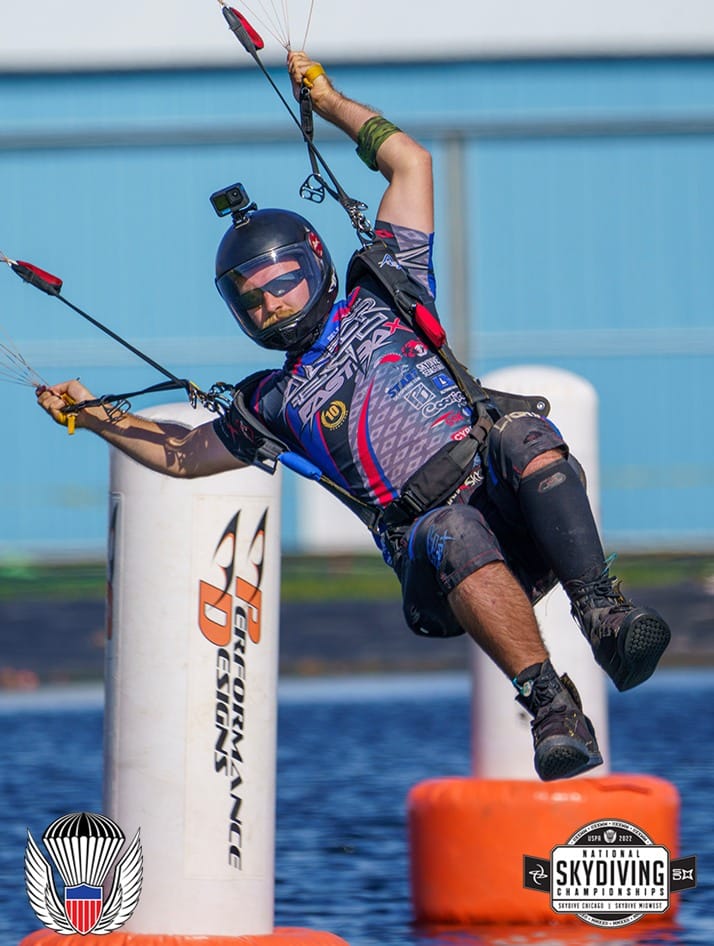
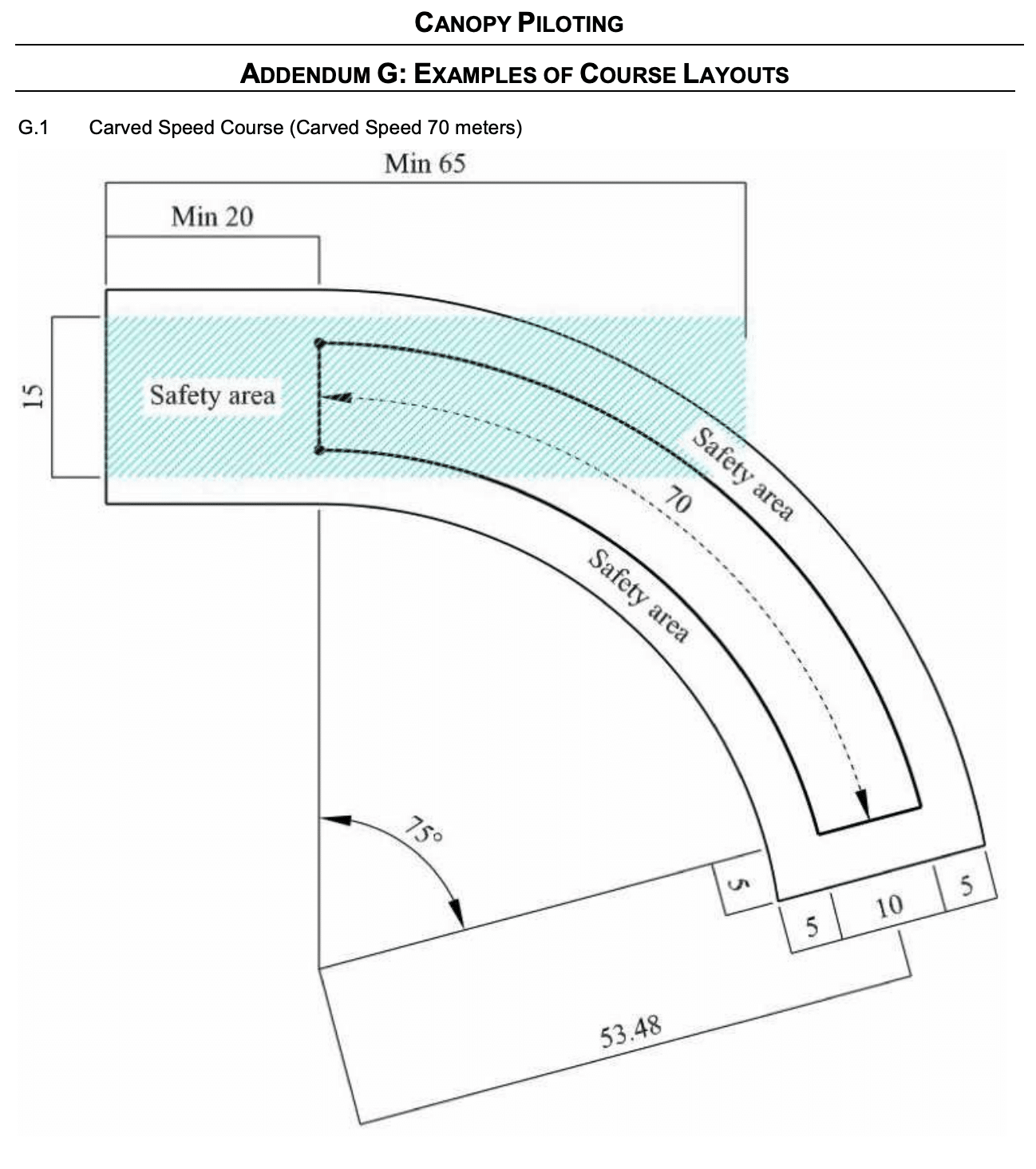
Distance - The competitor must drag a foot through the water prior to the first set of buoys (gate one) and must pass below and between the entry gates to the course. They must then fly their parachute as far as possible over the ground without touching it. Where they first make contact with the ground is the distance that will be recorded for their score. The greatest distance covered will win.
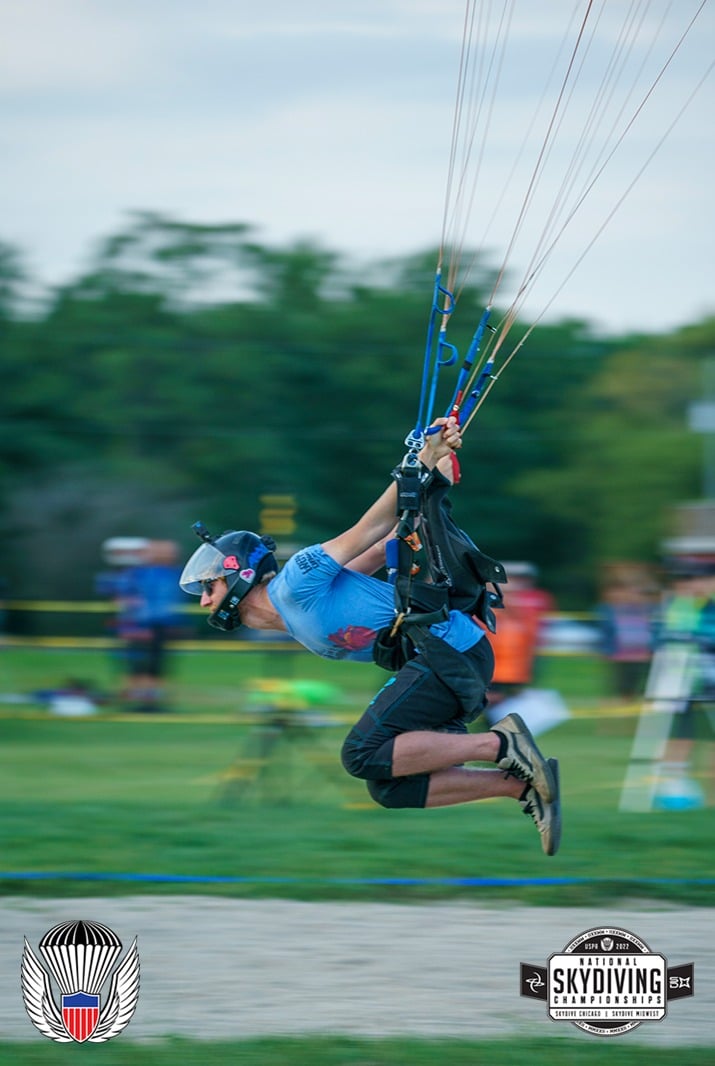
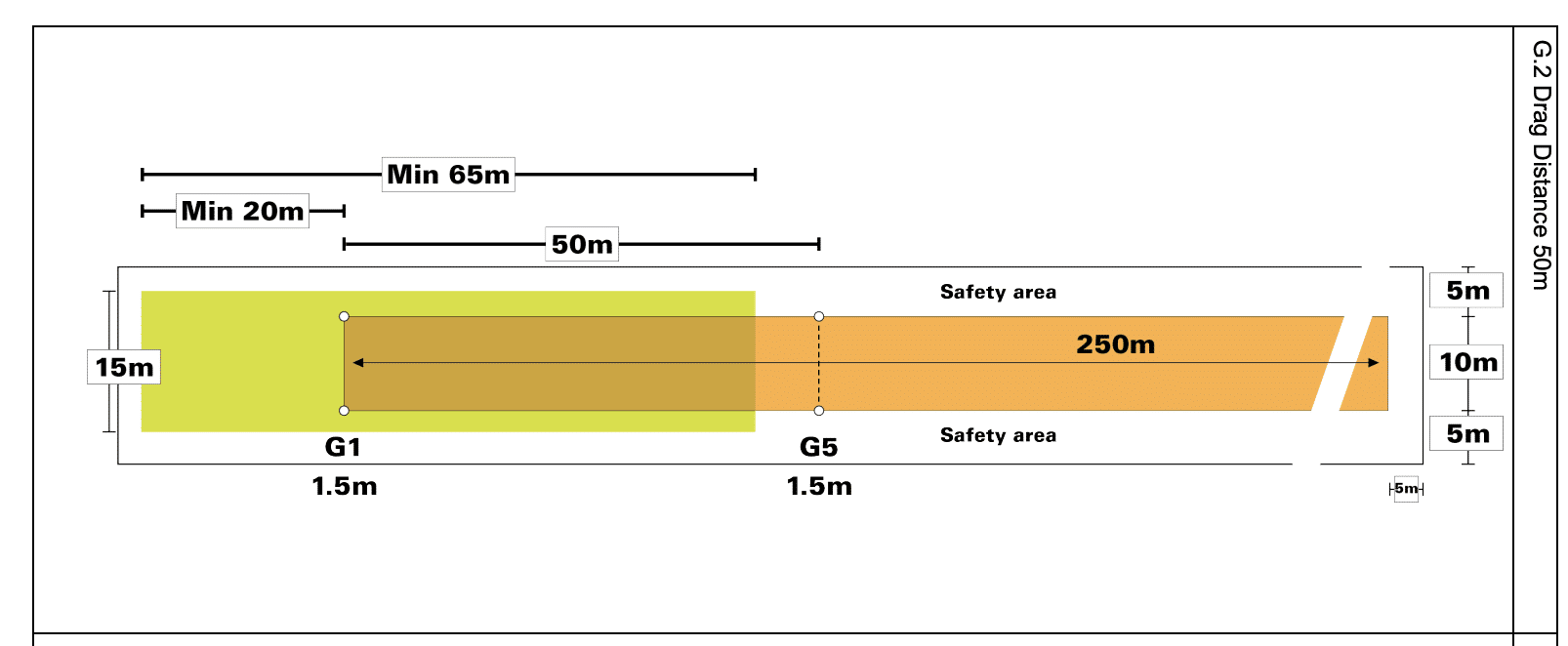
Zone Accuracy - The competitor must drag their foot through the water prior to the first set of buoys or entry gates. Additional points are awarded for maintaining contact with the water through the 3 following sets of gates or buoys. The competitor must then land as close as possible to a designated box, relatively in the center of the course. There are other boxes located prior, after and alongside the center box. Each of the other boxes are worth various, lesser points. They achieve extra points for landing on their feet.
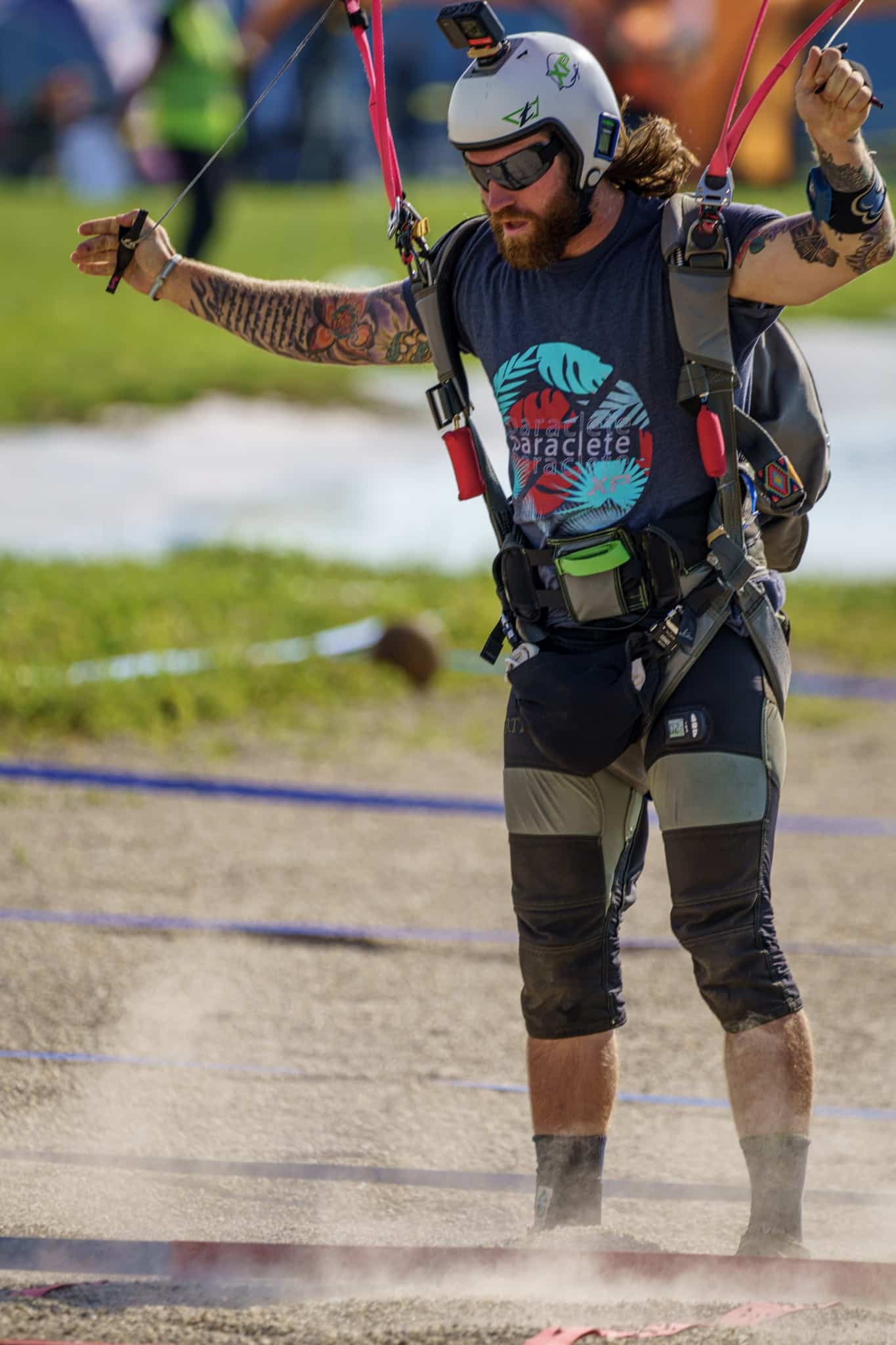
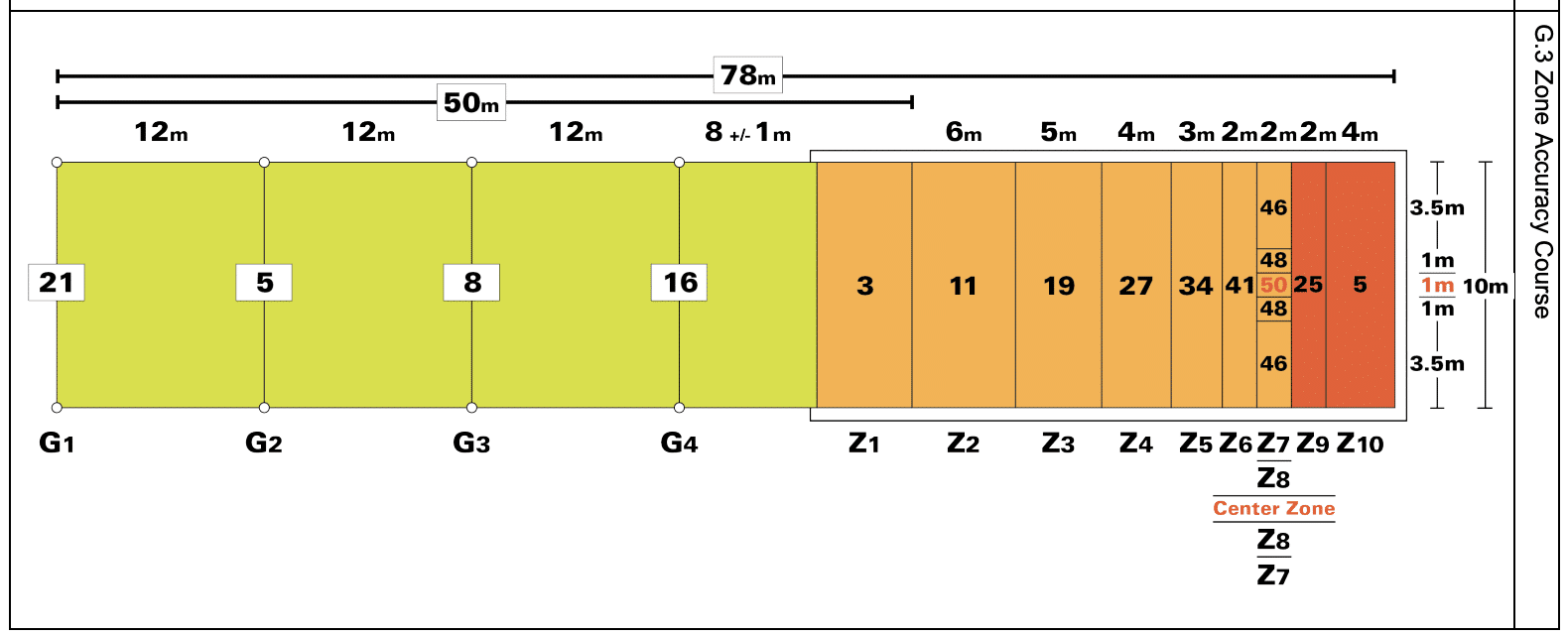
Freestyle -The competitor must perform a pre-declared trick or combination of tricks while maintaining contact with the water. They are judged on presentation, degree of difficulty and the landing. Points are deducted if the competitor does not land on their feet.
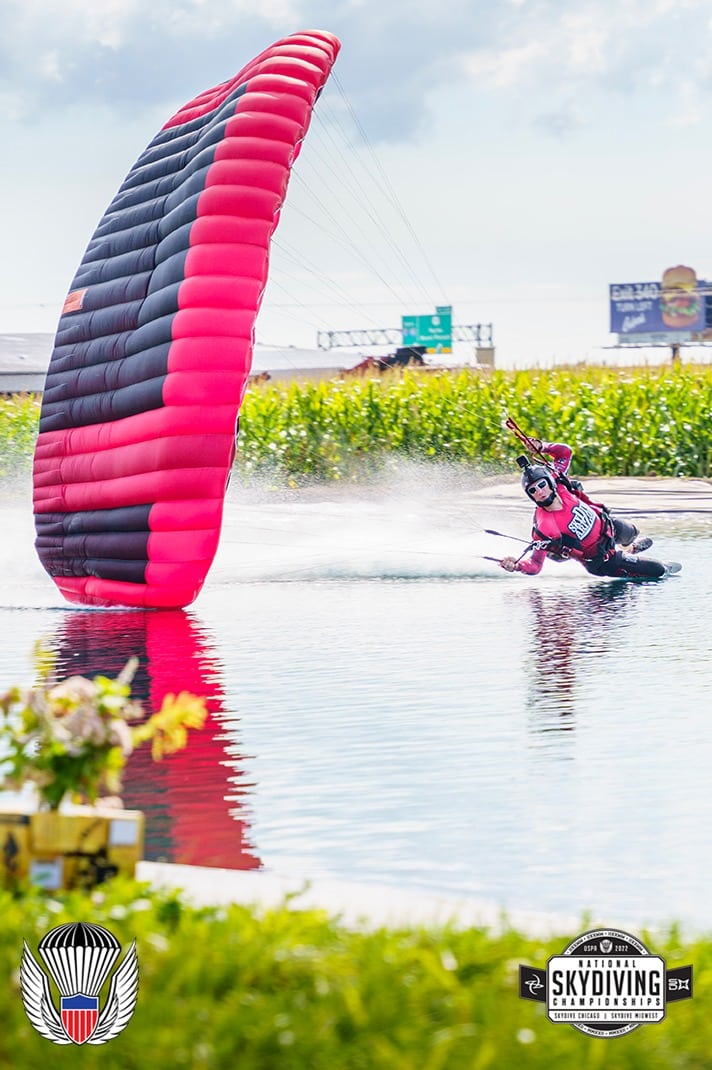
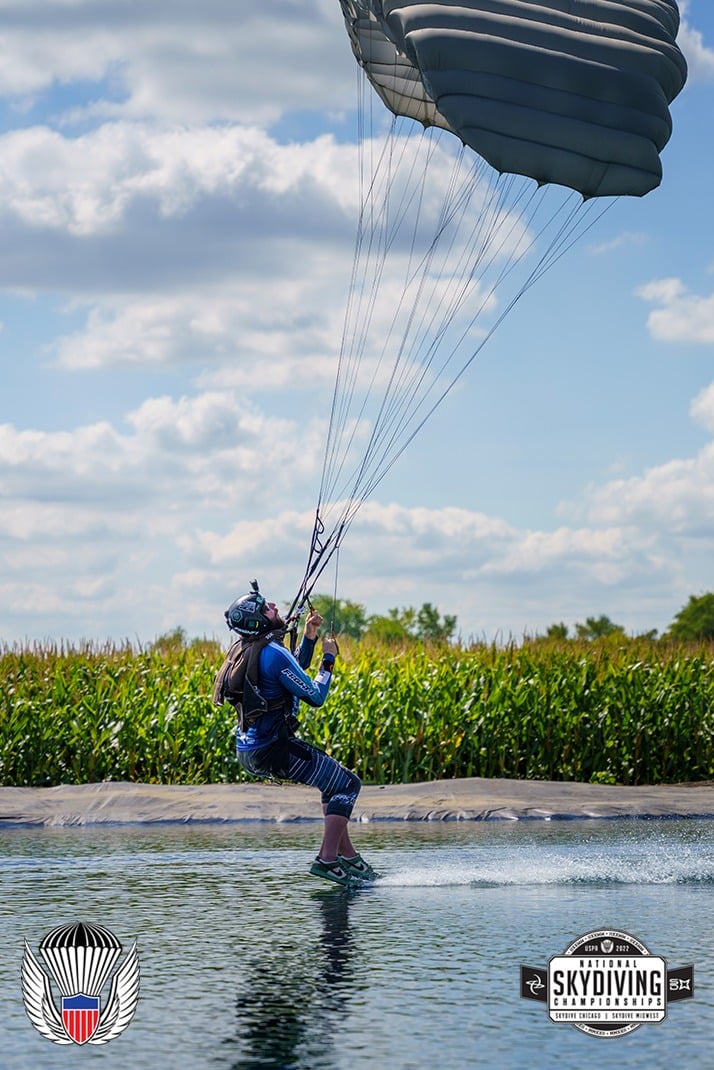
CANOPY RELATIVE WORK (CRW) AKA “CREW”
Crew is similar to formation skydiving in format, except that formations are built under canopy, rather than in freefall. Different canopy formations can be built by “docking” or connecting the parachutes together in flight. Teams consist of 2 or 4 competitors and a videographer to capture each round to submit for judging.
Sequential (2-way or 4-way) A sequence of 4-5 canopy formations is chosen from the potential divepool. The athletes must build and repeat the sequence of formations as many times as possible in the “working” time.
Rotation (4-way) All 4 canopy pilots must “dock” together, connecting themselves and their parachutes in a vertical “stack”. The canopy pilot at the top of the stack must then release and redock at the bottom of the stack. They will repeat this rotation as many times as possible in the allotted time.
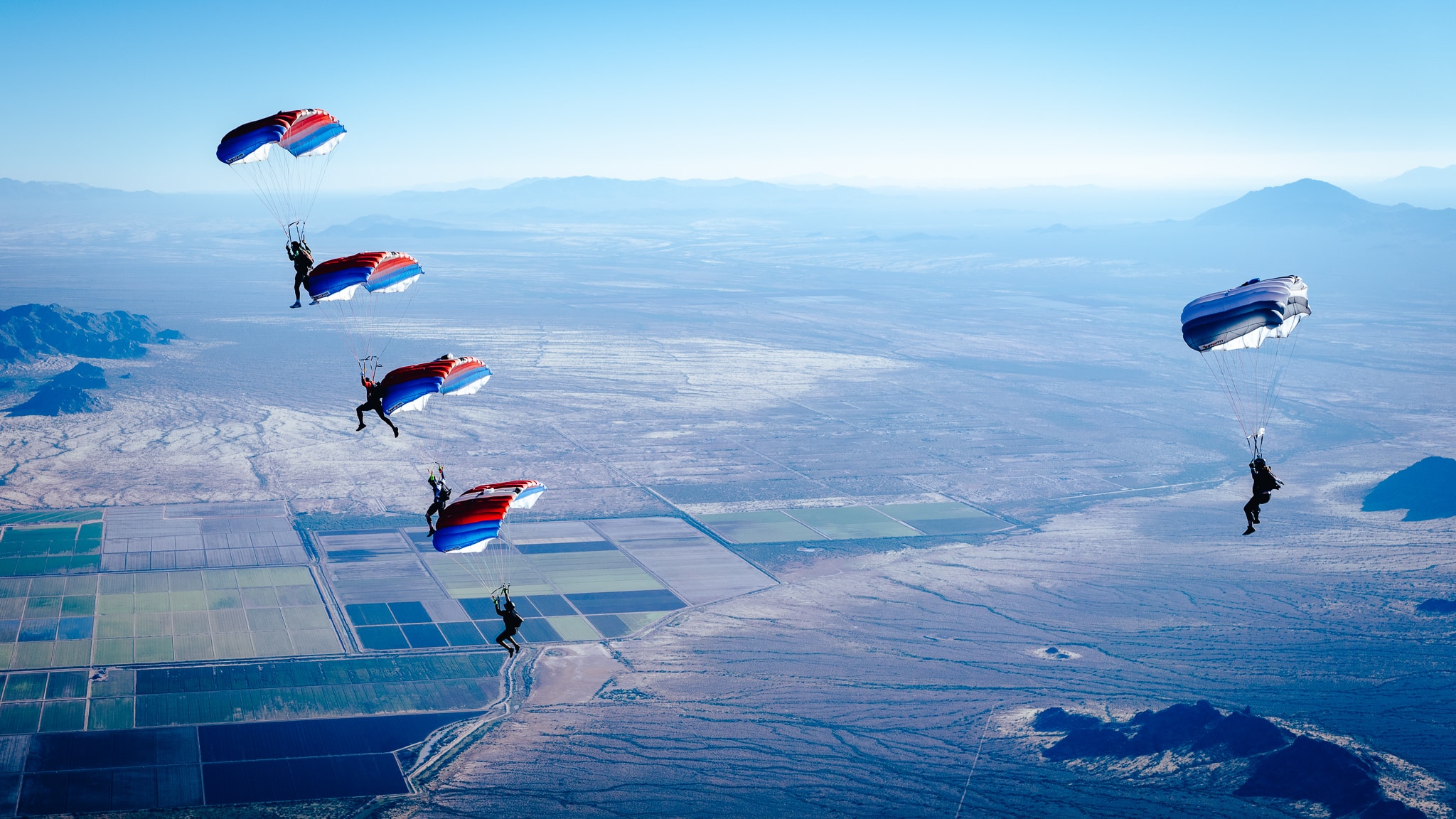
Wingsuiting
Performance- The objective is to fly a single wingsuit in three separate tasks to demonstrate a combination of best lift (time task), best glide (distance task) and least drag (speed task). Competitor must wear a Position Logging Devise (PLD) and submit the data for judging.
Acrobatic – Similar to Artistic Freeflying, this event is comprised of 2 performers and a videographer. Rounds consist of compulsory and free routines. Performers must exhibit maneuvers from a divepool as well as maneuvers chosen by the team.
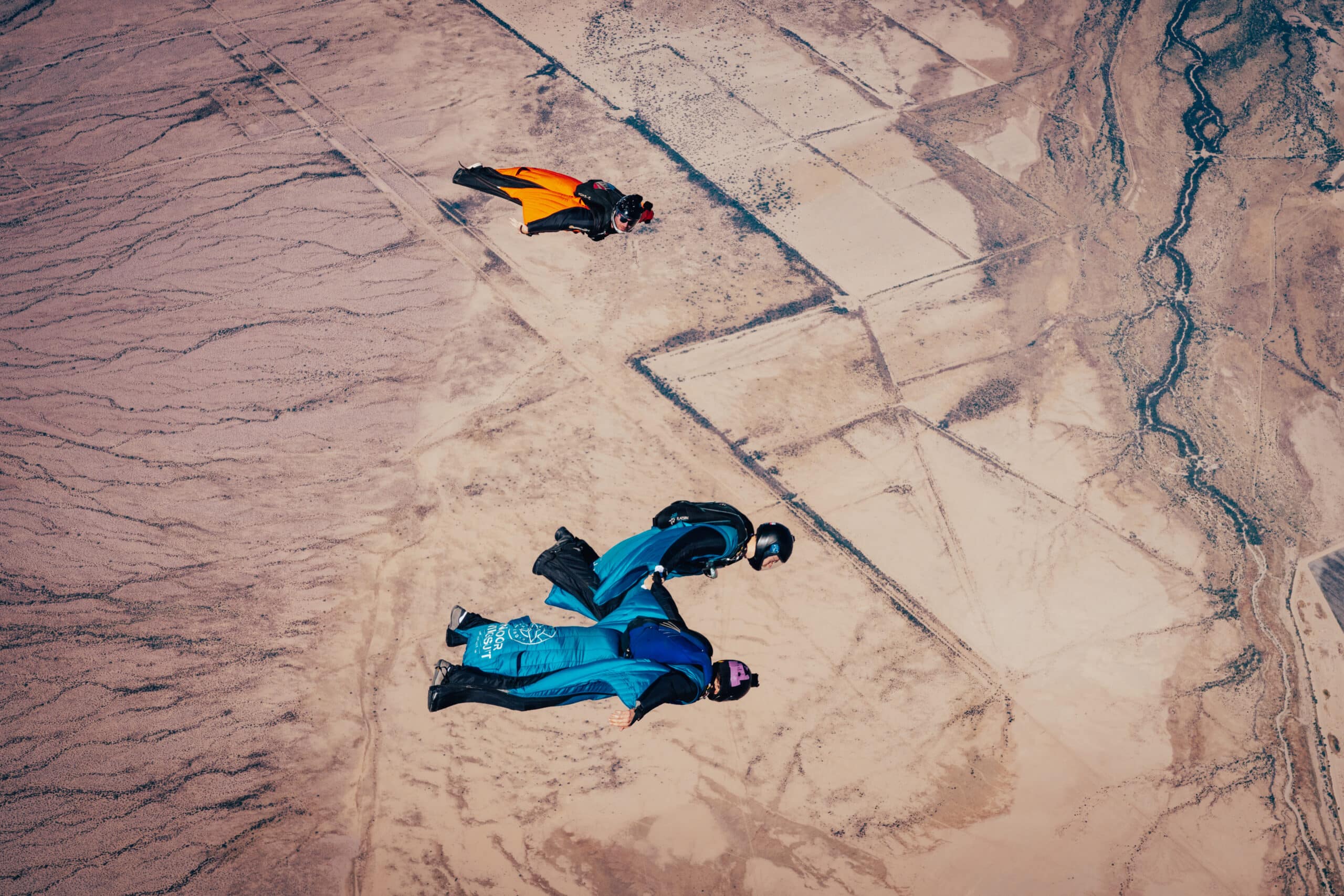
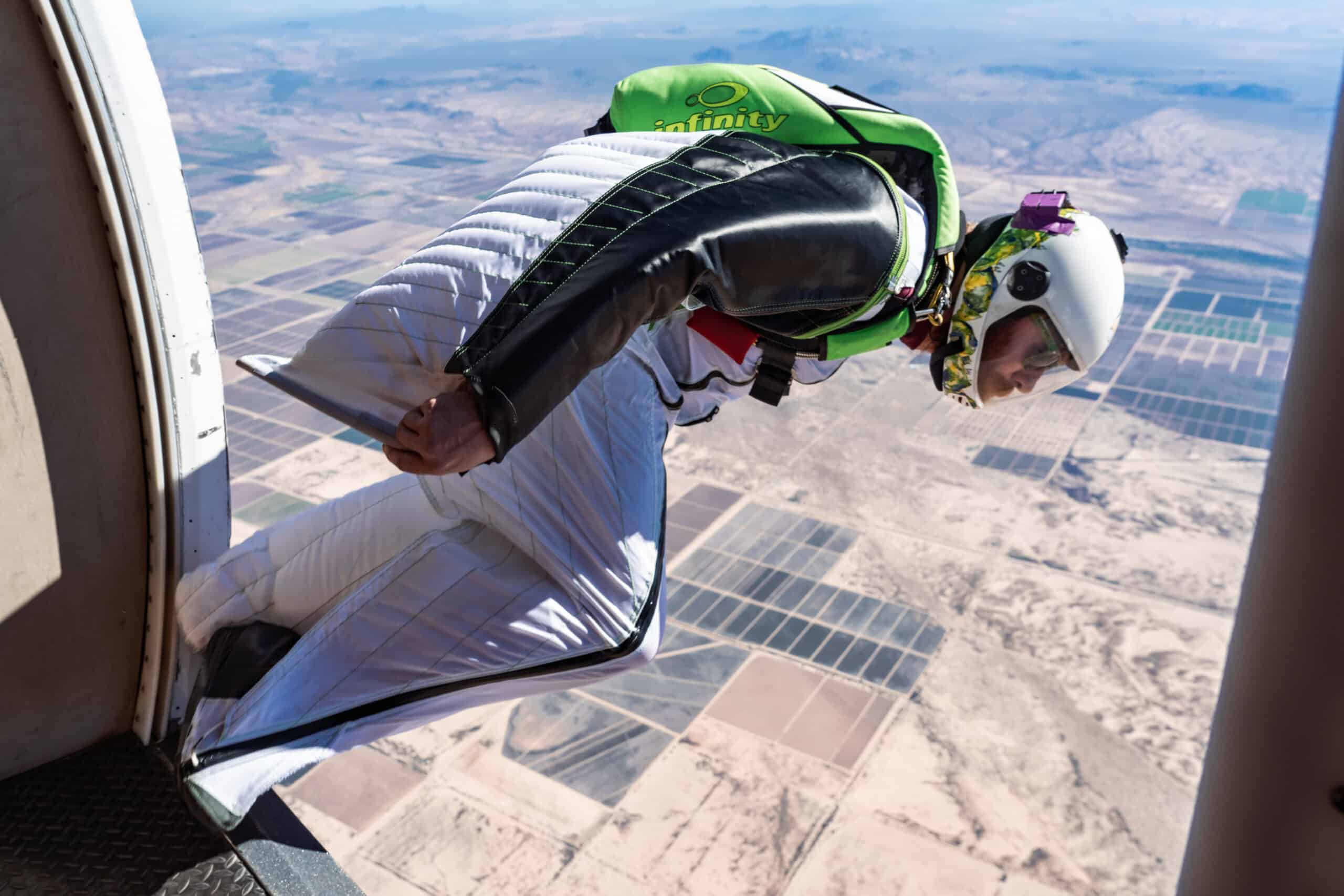
Speed
The objective of the event is for the competitor to fly their body as fast as possible to achieve the highest average vertical speed through a 3 second window. Each competitor must wear a device that monitors and records their speed. The highest speed recorded in a 3 second window of each flight will be added over 8 rounds. The highest total score wins. Athletes can reach speeds over 300mph!
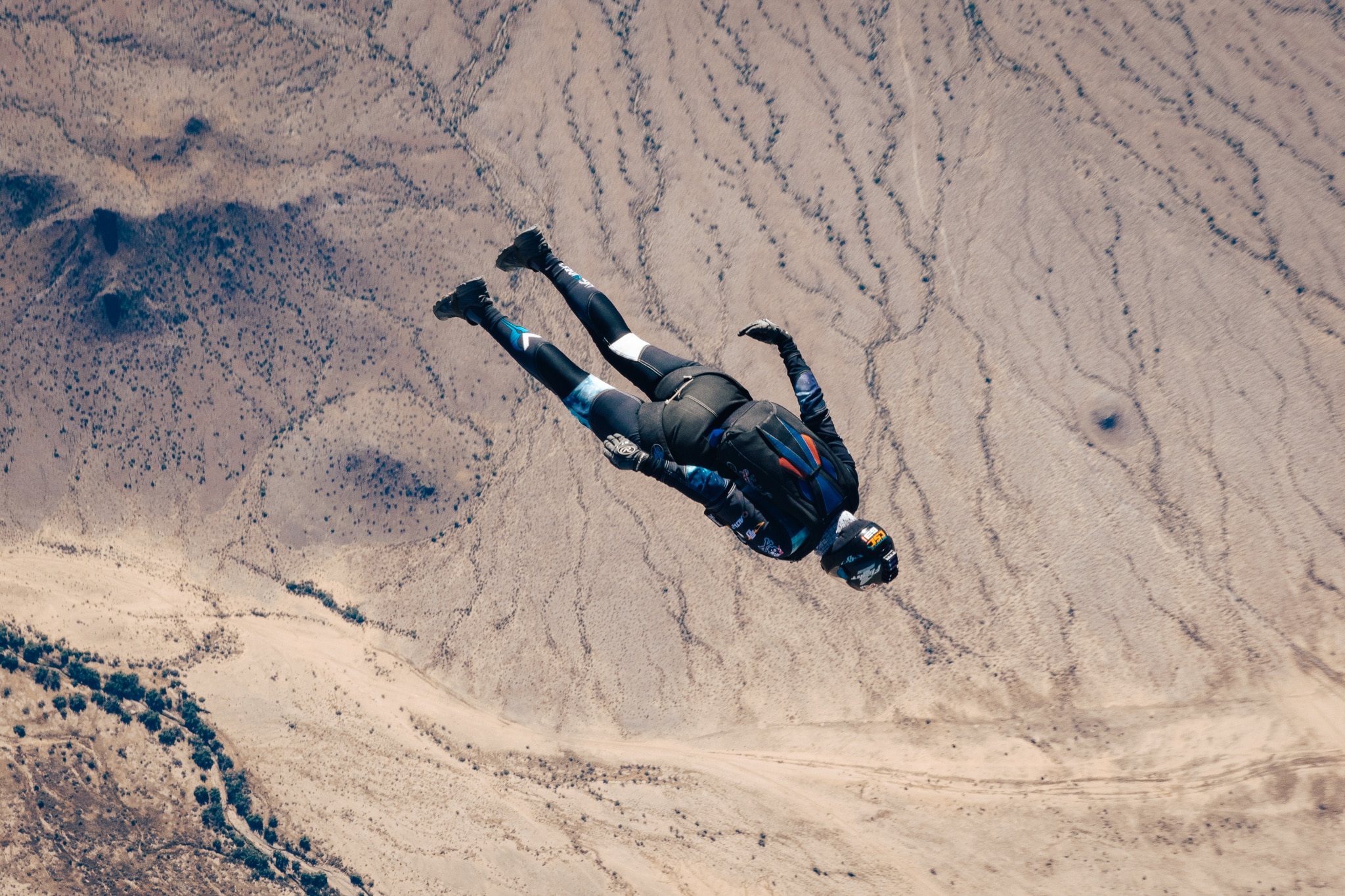
ACCURACY LANDING
Individual Accuracy- Each round consists of individual competitors guiding their canopies to a precision landing on an Automatic Measuring Device (AMD) with a two-centimeter-diameter (2 cm) dead-center target.
Team Accuracy- Each round consists of a team of 4 competitors making sequential precision approaches to an AMD with a two-centimeter diameter dead-center target.
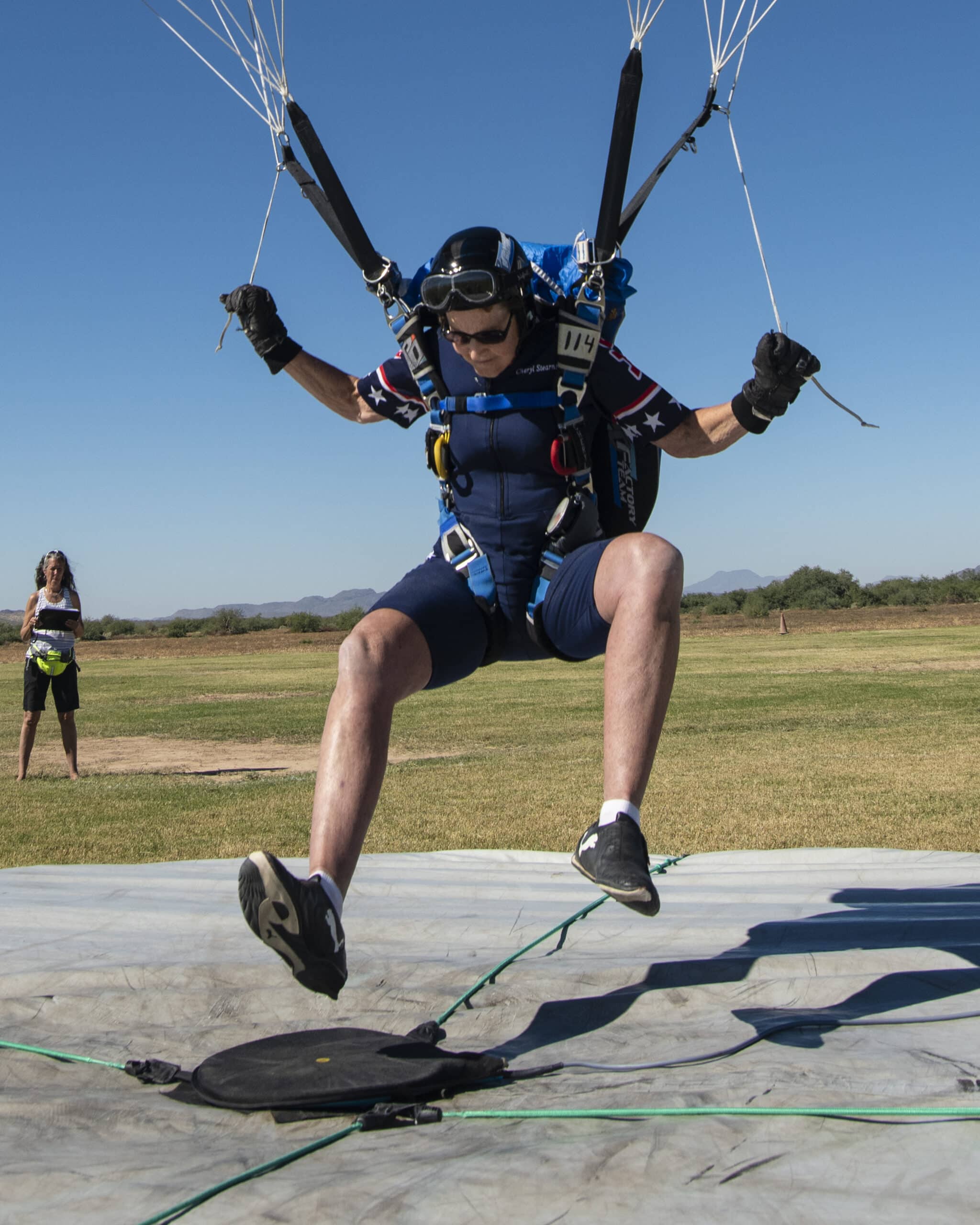
WE LOVE SKYDIVING ATHLETES
Competitive skydiving is a vital part of our sport. It is a platform which can be used to expose what we do to the world. It is a way to motivate ourselves and others to improve as skydivers and as individuals. We are honored to be the home of several national and world level skydiving competitors. There are no limits to what can be achieved by passionate, motivated athletes. Click here for more information on potential sponsorships and support for athletes and teams.
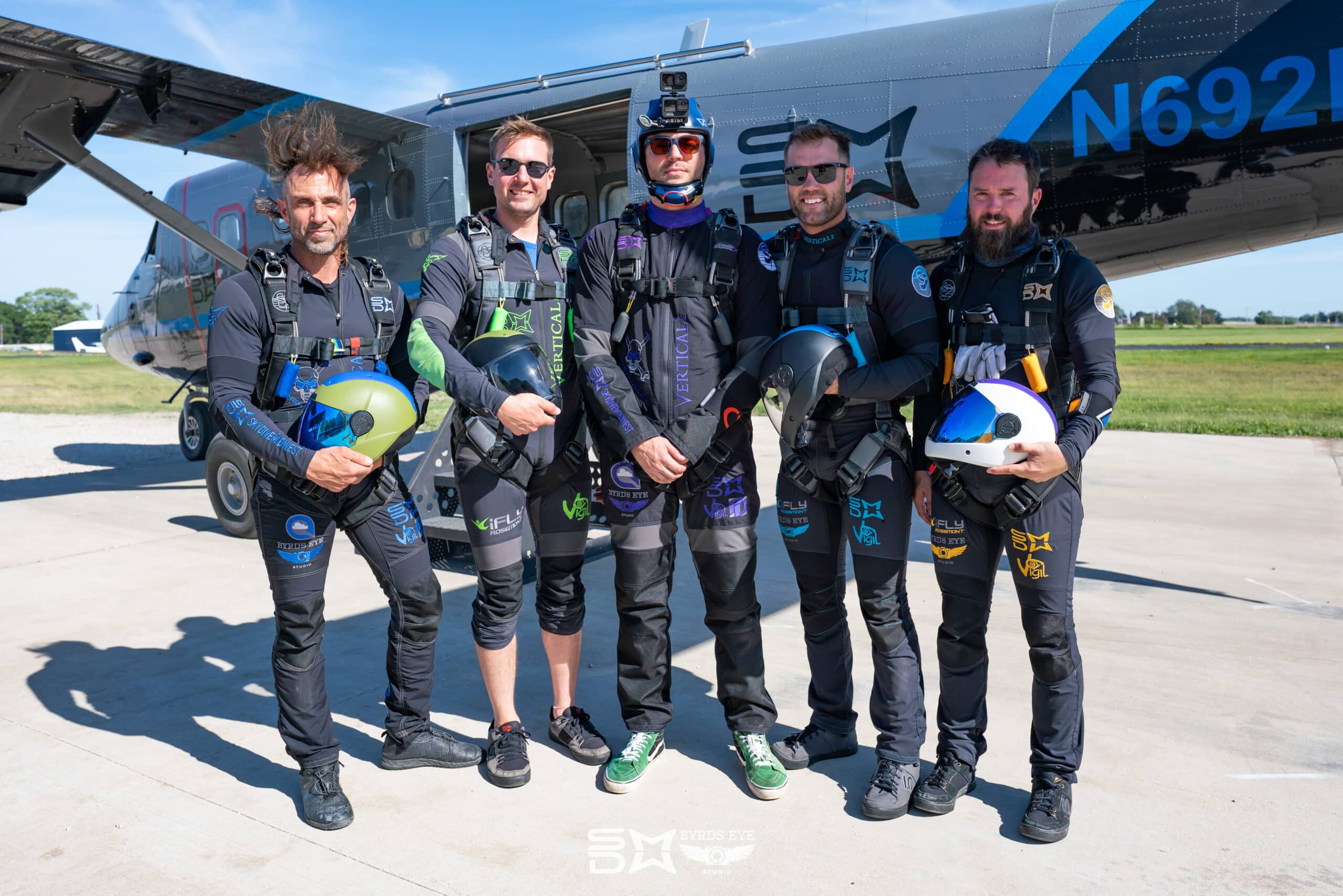
Resources
For a plethora of information on each discipline of competitive skydiving, check out the Skydiver’s Competition Manual. https://uspa.org/SCM

